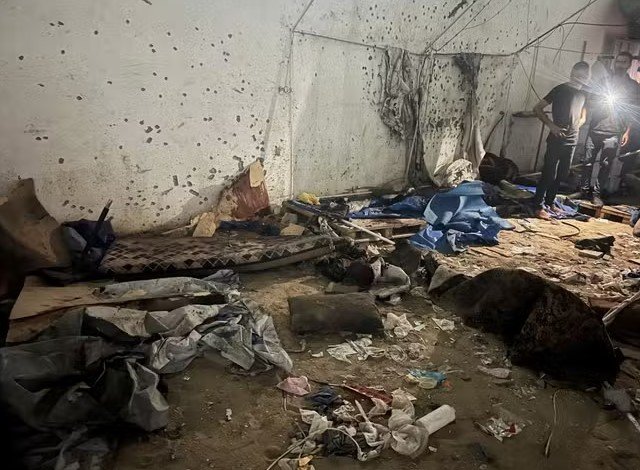Five Al Jazeera journalists, including well-known Gaza correspondent Anas al-Sharif, were killed in an Israeli strike near Al-Shifa Hospital on Sunday, the network says, sparking condemnation and reigniting debates over press safety in war zones.
A Strike in the Heart of Gaza’s Reporting Hub
It happened near the hospital’s main gate — a place that had become a makeshift media area for reporters covering the war from inside Gaza City.
According to Al Jazeera, al-Sharif, fellow correspondent Mohammed Qreiqeh, and cameramen Ibrahim Zaher, Mohammed Noufal, and Moamen Aliwa were inside a tent for journalists when it was hit. The broadcaster called the incident a “targeted assassination” and “a blatant attack on press freedom.”
Seven people died in total, the network added, revising its initial report of four journalist fatalities to five.
Israel’s Justification and the Evidence Gap
The Israel Defense Forces confirmed they had specifically targeted al-Sharif. In their statement, the IDF alleged he was “the head of a terrorist cell in Hamas” and had facilitated rocket attacks on Israeli civilians and troops.
But the Committee to Protect Journalists says there’s a pattern here — claims without supporting proof.
“This is something we’ve seen repeatedly,” CPJ’s CEO Jodie Ginsberg told the BBC. “Israel will say a journalist was also a terrorist but rarely provides evidence.”
One small but telling point: Israel has barred international reporters from freely entering Gaza since the war began, forcing global outlets to rely on local journalists like al-Sharif.
That restriction has amplified the stakes for reporters inside the enclave — and the risks they face.
A Familiar Face for Millions
Al-Sharif, 28, had been a constant presence on screens across the Arab world, reporting from northern Gaza’s most dangerous zones.
In his last moments online, he posted warnings on X (formerly Twitter) about heavy bombardment. A later post — likely scheduled or written by a colleague — appeared after news of his death broke.
Al Jazeera’s managing editor Mohamed Moawad described him as “the only voice” many viewers had from inside the besieged strip.
“They weren’t at the front line,” Moawad stressed. “They were targeted in their tent.”

Witness Accounts from the Scene
Two verified videos from BBC Verify show the immediate aftermath: bodies being carried, voices calling out Qreiqeh’s name, a man in a media vest identifying al-Sharif’s remains.
Some of those present seemed stunned into silence, others shouted in grief.
It wasn’t the chaos of combat. It was the targeted destruction of a place journalists believed to be relatively safe.
Media Casualties in the Gaza War
The strike adds to a grim tally of journalists killed since the conflict reignited. According to CPJ, dozens have died in Gaza over the past ten months — one of the highest fatality rates for media workers in any recent conflict.
Here’s a snapshot of reported journalist fatalities during the current war, based on CPJ and press reports:
| Period (Oct 2023 – Aug 2025) | Journalists Killed | Notes |
|---|---|---|
| First month | 31 | Heavy strikes across Gaza |
| Following 6 months | 22 | Concentrated in urban areas |
| Past 3 months | 9 | Including Al Jazeera crew |
Such numbers point to what many in the industry see as an alarming disregard for press immunity.
International Reaction and Press Freedom Debate
Criticism of Israel’s strike came quickly. Rights groups and journalist associations demanded independent investigations, accusing the military of using unproven terror allegations to justify targeting reporters.
Media freedom advocates say the tactic undermines the protections journalists are supposed to have under international law.
Meanwhile, Israel’s defenders argue that if journalists are actively engaged in hostile activities, they lose those protections. But proving that in a credible and transparent way, critics say, remains essential.
The War Without Witnesses
Without foreign reporters on the ground, coverage of Gaza is heavily dependent on local journalists — many of whom have no escape routes and limited safety options.
-
Al Jazeera has repeatedly accused Israel of deliberately targeting its staff.
-
The network says these attacks aim to suppress coverage from inside Gaza.
-
Press unions warn that the loss of local reporters means entire stories will never be told.
The absence of independent access means audiences abroad often receive filtered or delayed information, heightening suspicion on all sides.
Questions That May Never Be Answered
Was al-Sharif truly part of a Hamas unit? Or was he, as colleagues insist, simply a dedicated journalist doing his job?
Those answers may remain elusive. Gaza’s warzone conditions make impartial investigation extraordinarily difficult. Evidence can be buried — literally — under rubble within hours.
And in the meantime, the toll rises, and the space for neutral reporting shrinks.








